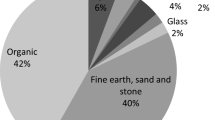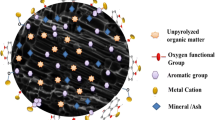Abstract
Symbiotic cellulolytic microcosms represent a promising microbial agent for enhancing degradation of cellulosic materials in biotechnological processes. In this study, structurally stable lignocellulose-degrading microbial communities were constructed from cellulolytic seed culture from sugarcane bagasse compost using swine manure and Napier grass as co-digested carbon sources under static aerobic condition at 55 °C. The lignocellulolytic microbial consortium enriched in peptone and yeast extract-based medium (PLMC) showed higher cellulose-degrading activity compared to lignocellulolytic microbial consortium isolated in the water-based medium (WLMC). The composite microbes in both consortia were originated from the seed culture and the co-digested substrates according to denaturing gradient gel electrophoresis profile. PLMC exhibited higher CMCase, xylanase, FPase, and avicelase activities in the supernatant than those of WLMC and was capable of degrading 70 % of filter paper within 1 week. PLMC was capable of degrading substrate with higher efficiency than the control by 11.7, 9.2, 15.5, and 11.9 % of total solid, suspended solid, volatile solid, and volatile suspended solid, respectively. The work demonstrated the potential of cellulolytic microcosms enriched by this approach on enhancing conversion efficiency in biogas production from cellulosic wastes.



Similar content being viewed by others
References
Vavilin VA, Fernandez B, Palatsi J, Flotats X (2008) Hydrolysis kinetics in anaerobic degradation of particulate organic material: an overview. Waste Manag 28:939–951. doi:10.1016/j.wasman.2007.03.028
Sun Y, Cheng J (2002) Hydrolysis of lignocellulosic materials for ethanol production: a review. Bioresource Technol 83:1–11
Recktenwald M, Wawrzynczyk J, Dey ES, Norrlöw O (2008) Enhanced efficiency of industrial-scale anaerobic digestion by the addition of glycosidic enzymes. J Environ Sci Heal A Tox Hazard Subst Environ Eng 43:1536–1540. doi:10.1080/10934520802293693
Howard RL, Abotsi E, Jansen van Rensburg EL, Howard S (2003) Lignocellulose biotechnology: issues of bioconversion and enzyme production: review. Afr J Biotechnol 2:602–619
Haruta S, Cui Z, Huang Z, Li M, Ishii M, Igarashi Y (2002) Construction of a stable microbial community with high cellulose-degradation ability. Appl Microbiol Biotechnol 59:529–534. doi:10.1007/s00253-002-1026-4
Wongwilaiwalin S, Rattanachomsri U, Laothanachareon T, Eurwilaichitr L, Igarashi Y, Champreda V (2010) Analysis of a thermophilic lignocellulose degrading microbial consortium and multi-species lignocellulolytic enzyme system. Enzyme Microb Tech 47:283–290. doi:10.1016/j.enzmictec.2010.07.013
Yang HY, Wu H, Wang XF, Cui ZJ, Li YH (2011) Selection and characteristics of a switchgrass-colonizing microbial community to produce extracellular cellulases and xylanases. Bioresource Technol 102:3546–3550. doi:10.1016/j.biortech.2010.09.009
Zhang Q, He J, Tian M, Mao Z, Tang L, Zhang J, Zhang H (2011) Enhancement of methane production from cassava residues by biological pretreatment using a constructed microbial consortium. Bioresource Technol 102:8899–8906. doi:10.1016/j.biortech.2011.06.061
Yuan X, Cao Y, Li J, Wen B, Zhu W, Wang X, Cui Z (2012) Effect or pretreatment by a microbial consortium on methane production of waste paper and cardboard. Bioresource Technol 118:281–288. doi:10.1016/j.biortech.2012.05.058
Wen B, Yuan X, Cao Y, Liu Y, Wang X, Cui Z (2012) Optimization of liquid fermentation of microbial consortium WSD-5 followed by saccharification and acidification of wheat straw. Bioresource Technol 118:141–149. doi:10.1016/j.biortech.2012.05.025
Yan L, Gao Y, Wan Y, Liu Q, Sun Z, Fu B, Wen X, Cui Z, Wang W (2012) Diversity of a mesophilic lignocellulolytic microbial consortium which is useful for enhancement of biogas production. Bioresource Technol 111:49–54. doi:10.1016/j.biortech.2012.01.173
Tuesorn S, Wongwilaiwalin S, Champreda V, Leethochawalit M, Nopharatana A, Techkarnjanaruk S, Chaiprasert P (2013) Enhancement of biogas production from swine manure by a lignocellulolytic microbial consortium. Bioresource Technol 144:579–586. doi:10.1016/j.biortech.2013.07.013
Cuetos MJ, Fernandez C, Gomez X, Moran A (2011) Anaerobic co-digestion of swine manure with energy crops. Biotechnol Bioprocess Eng 16:1044–1052
Wang X, Yang Y, Feng Y, Ren G, Han X (2012) Optimizing feeding composition and carbon–nitrogen ratios for improved methane yield during anaerobic co-digestion of dairy, chicken manure and wheat straw. Bioresource Technol 120:78–83. doi:10.1016/j.biortech.2012.06.058
Sawasdee V, Pisutpaisalb N (2014) Feasibility of biogas production from napier grass: The 6th International Conference on Applied Energy—ICAE2014. Energy Procedia 61:1229–1233. doi:10.1016/j.egypro.2014.11.1064
Okaraonye CC, Ikewuchi JC (2009) Nutritional and antinutritional components of Pennisetum purpureum (Schumach). Pak J Nutr 8:32–34. doi:10.3923/pjn.2009.32.34
APHA (2005) Standard methods for the examination of water and wastewater. American Public Health Association, Washington, DC
Zhou J, Bruns MA, Tiedje JM (1996) DNA recovery from soils of diverse composition. Appl Environ Microb 62:316–322
Rattanachomsri U, Tanapongpipat S, Eurwilaichitr L, Champreda V (2009) Simultaneous non-thermal saccharification of cassava pulp by multi-enzyme activity and ethanol fermentation by Candida tropicalis. J Biosci Bioeng 107:488–493. doi:10.1016/j.jbiosc.2008.12.024
Ye J, Li D, Sun Y, Wang G, Yuan Z, Zhen F, Wang Y (2013) Improved biogas production from rice straw by co-digestion with kitchen waste and pig manure. Waste Manag 33:2653–2658. doi:10.1016/j.wasman.2013.05.014
Li, Y, Zhang, R, Chen, C, Liu, G, He, Y, Liu, X (2013) Biogas production from co-digestion of corn stover and chicken manure under anaerobic wet, hemi-solid, and solid state conditions. Bioresource Technol 149: 406–412. doi.org/10.1016/j.biortech.2013.09.091
Abouelenien, F, Namba, Y, Kosseva, MR, Nishio, N, Nakashimada, Y (2014) Enhancement of methane production from co-digestion of chicken manure with agricultural wastes. Bioresource Technol 159: 80–87. doi.org/10.1016/j.biortech.2014.02.050
Kato S, Haruta S, Cui ZJ, Ishii M, Igarashi Y (2005) Stable coexistence of five bacterial strains as a cellulose degrading community. Appl Environ Microb 71:7099–7106
Acknowledgments
This study was financially supported by The Joint Graduate School of Energy and Environment (JGSEE) at King Mongkut’s University of Technology Thonburi (KMUTT).
Author information
Authors and Affiliations
Corresponding author
Rights and permissions
About this article
Cite this article
Wongwilaiwalin, S., Mhuantong, W., Tangphatsornruang, S. et al. Isolation of cellulolytic microcosms from bagasse compost in co-digested fibrous substrates. Biomass Conv. Bioref. 6, 421–426 (2016). https://doi.org/10.1007/s13399-016-0199-5
Received:
Revised:
Accepted:
Published:
Issue Date:
DOI: https://doi.org/10.1007/s13399-016-0199-5




